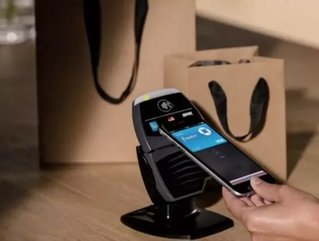Payment via digital wallets to reach $189B by 2018 thanks to Apple Pay

Apple unveiled plenty yesterday, but their support of near-field communication (NFC) through Apple Pay is set to be the tipping point in widespread adoption of the mobile wallet. This is big news from a retail revenue standpoint because mobile payment programs mean more spending – twice as much according to a recent study. Here's an example: Starbucks sees 11 percent of its sales through its successful mobile wallet loyalty app, and the man behind it was recruited by Apple to create Apple Pay. Until this point, it's merely been the lack of program availability holding back a major shift in how we pay at the checkout line.
The rise of digital wallets
As the use of cash and checks declines, credit and debit card use increases. This trend has helped merchants by reducing barriers to sales and helped consumers by increasing convenience and security. Phase one of this digital cash transition, mobile credit card readers, has been happening for years, with mobile card reader technology making it easier and more affordable for merchants to accept credit and debit cards. Phase two is just beginning with digital wallets built into consumer smart phones and readers that can accept payments becoming more common at merchants.
Purchase barriers are disappearing. Anyone from a taxi driver to a food truck merchant can now accept your credit card. The US Treasury estimates that card-based mobile commerce will grow to $222 billion by 2018. Payments via digital wallets in consumer phones are just getting started but expected to grow quickly, reaching $189 billion per year by 2018. Source: Business Insider, The Future of Payments.
The development of mobile commerce
Mobile card swipe devices that attach to a mobile phone or tablet allow merchants’ to easily accept customer credit card payments from customers. Merchant mobile apps and devices are becoming more common, with growing competition to provide mobile commerce services. Some examples follow.
- On August 13, 2014, Amazon launched Local Register, a mobile credit card reader and app that streamlines credit card acceptance via a merchant’s mobile phone or tablet. A key benefit is low transaction costs. Local Register offers low rates (1.75%), high security and easy purchase tracking online. Mobile payment competitors include Square and PayPal.
- Square is one of the first services to add an EMV and chip-compatible card reader dongle that allows mobile payment via more-secure chip-enabled cards. EMV stands for Europay, MasterCard and Visa, a global standard for inter-operation of integrated circuit cards (IC cards or "chip cards") and IC card capable point of sale (POS) terminals and automated teller machines (ATMs), for authenticating credit and debit card transactions. This standard in Europe and Canada is scheduled to be adopted on US cards by 2015.
Digital wallets to pave the way for future payments
The line between credit card and smart phone is rapidly blurring. The Smart Card Alliance points to “contactless payments” as the inevitable future, using either chip-embedded cards or smart phones with NFC technology. Their research says the trend favors smartphones, because few people leave home without their phone. Money may be transferred via bar codes, QR codes, or near-field communication (NFC) signals.
- Google Wallet allows consumers to pay merchants or individuals via their smartphone or online from their bank account or Google Wallet balance. The service aims to replace customers’ credit cards and loyalty cards. Users receive transaction alerts instantly.
- Isis Wallet is a phone-based app specific to Verizon network phones. The app partners with American Express, Chase, Wells Fargo and other debit and credit cards. Similar to its competitor, Google Wallet, Isis also manages special offers and loyalty programs with participating merchants.
- Starbucks stores now accept more than 4 million mobile wallet payments per week. Their mobile payment system ties into a customer’s credit card for payment. The company rolled its barcode-based scan system out to customers in 2009. The customer’s phone displays a bar code on its screen, which is scanned at the register. In one scan, funds are transferred from a customer’s designated account and loyalty program data is recorded in a new twist on old “punch card” loyalty programs. Starbucks reports that 11 percent of its sales are now through its mobile wallet app. As NFC catches on, Starbucks says it can quickly adapt to use that technology as well.
- Dwolla is a payment system that offers low transaction rates (25 cents for purchases over $10) for merchants and convenient, secure payments for consumers. The service partners with Veridian credit union to transfer funds directly from customer accounts without the need for a credit card.
Dwolla allows payments to individuals or merchants via NFC smartphone, email, LinkedIn or Twitter.
- Wearable technology, such as smart watches or Google Glass, offers another potential way to make and accept payments. Voice commands tend to be the best way to interface with mobile tech, and a study by US Bank showed that customers tend to be uncomfortable making transactions via voice commands. But as people in the study got used to wearing the devices, they became more comfortable. Research on the viability of mobile payments via wearable devices continues.
- One way around the voice command conundrum is to use a QR code scanning system. Bendigo Bank in Australia is among those testing QR code mobile payments. The merchant generates a unique QR code at the point of sale. To pay, the customer then scans the QR code with the camera on their app-enabled phone.
- Mobile payment users, on average, spend approximately twice as much through all digital channels than those not using mobile payments. Source: Bain & Company
- And finally Apple Pay has entered the market place to catapult its adoption and popularity to new heights.






